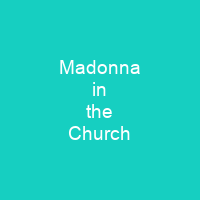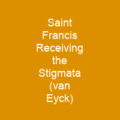Madonna in the Church: A Masterpiece by Jan van Eyck
Is there any painting more captivating than Madonna in the Church, a small oil panel by Jan van Eyck, created between 1438-1440? This exquisite work of art not only showcases the pinnacle of Northern Renaissance painting but also delves into the profound symbolism and intricate details that make it a masterpiece. The painting features tracery with wooden carvings of episodes from Mary’s life and a faux bois sculpture showing her holding the child, creating an almost lifelike scene.
Erwin Panofsky once described this painting as if sculptures had come to life, emphasizing its unique blend of realism and divine presence. The closely observed beams of light flooding through the cathedral’s windows symbolize Mary’s purity and God’s presence, making it a visual representation of the Incarnation itself. Could there be any other painting that so vividly captures the essence of light and spirituality?
The Painting’s History and Attribution
Madonna in the Church is considered the left wing of a dismantled diptych, with its opposite wing being a votive portrait. Contemporary copies by the Master of 1499 and Jan Gossaert made significant alterations to van Eyck’s composition, but these do not detract from the original’s brilliance. The painting was first documented in 1851 and has undergone debates about dating and attribution.
It is now definitively attributed to Jan van Eyck and believed to be a later work, demonstrating techniques present in works from the mid-1430s and later. The panel was acquired for the Berlin Gemäldegalerie in 1874 and stolen in 1877 but returned without its original frame. Today, it is widely considered one of van Eyck’s finest works, with Millard Meiss writing that its depiction of light is unsurpassed in Western art.
The Artistic Techniques
Van Eyck’s earlier work often shows churches and cathedrals in older Romanesque style, sometimes to represent the Temple in Jerusalem as an appropriate historical setting. However, Madonna in the Church is different – the Christ Child occupies the same space as a large rood cross depicting him being crucified. The church in this panel is contemporary Gothic, a choice perhaps intended to associate Mary with the Ecclesia Triumphans while her pose and oversized scale are indebted to Byzantine art and the International Gothic.
The painting depicts Mary wearing a dark blue robe with gold embroidery and holding the infant Jesus. It includes depictions of her life stages and shows shadows and light in an unusually realistic manner for early 15th-century art. The frame is described as having a rounded top, but its current form is considered too narrow and small.
The Symbolism
Light plays a crucial role in the painting, symbolizing the divine and representing the mystery of the Incarnation. Light acts as a visual symbol for both the Immaculate Conception and Christ’s birth. The painting depicts Mary holding a central position in Christian iconography, surrounded by pools of light that create a mystical atmosphere, with statues lit by two candles.
The different elements of the cathedral are so specifically detailed and the elements of Gothic and contemporary architecture so well delineated, that art and architecture historians have concluded that van Eyck must have had enough architectural knowledge to make nuanced distinctions. The transition from foreground to background is obscured by the figure of the Madonna, who masks the crossing pier and eliminates the middle ground.
The Composition
Most windows in a 13th-century Gothic cathedral are made of clear glass, but one window above the crucifix shows intricately designed stained glass panels with intertwined red and blue flowers that appear to be growing from the top of the cross. This illusion is not due to loss of perspective, but rather a reference to the iconography of the Book of Genesis’ Tree of life.
The panel features light as a motif, symbolizing the divine and representing the mystery of the Incarnation. Light acts as a visual symbol for both the Immaculate Conception and Christ’s birth. The painting depicts Mary holding a central position in Christian iconography, surrounded by pools of light that create a mystical atmosphere, with statues lit by two candles.
The Attribution and Provenance
Van Eyck’s earlier work often shows churches and cathedrals in older Romanesque style, sometimes to represent the Temple in Jerusalem as an appropriate historical setting. However, Madonna in the Church is different – the Christ Child occupies the same space as a large rood cross depicting him being crucified. The church in this panel is contemporary Gothic, a choice perhaps intended to associate Mary with the Ecclesia Triumphans while her pose and oversized scale are indebted to Byzantine art and the International Gothic.
The painting depicts Mary wearing a dark blue robe with gold embroidery and holding the infant Jesus. It includes depictions of her life stages and shows shadows and light in an unusually realistic manner for early 15th-century art. The frame is described as having a rounded top, but its current form is considered too narrow and small.
The provenance of the work contains many gaps, and there is almost no record from the early 16th century through 1851. A Madonna in a church nave holding the Christ Child in her right arm was documented in 1851, described as ‘painted on wood, very well preserved, still in its original frame’. A Virgin panel was recorded in 1855 and believed to be by Hubert and Jan van Eyck. The painting was stolen in 1877 but recovered ten days later without the original frame.
The Berlin museum catalogue attributed a van Eyck imitator to the painting in 1875, then described it as lost and the Berlin painting a copy in 1883. However, its authenticity was verified soon after, and by 1904, the 1904 Berlin catalogue attributed Jan.
Philip the Good may have been the original patron, given that a matching description was recorded in an inventory of his great-granddaughter’s collection in 1567. Could there be any other painting that so vividly captures the essence of light and spirituality?
The Madonna in the Church is not just a painting; it’s a window into the divine, a testament to Jan van Eyck’s genius, and a timeless masterpiece that continues to inspire awe and wonder.
You want to know more about Madonna in the Church?
This page is based on the article Madonna in the Church published in Wikipedia (retrieved on November 29, 2024) and was automatically summarized using artificial intelligence.








